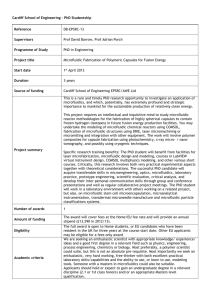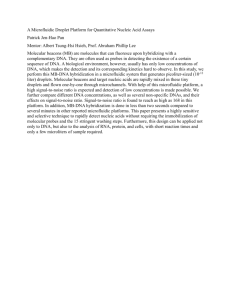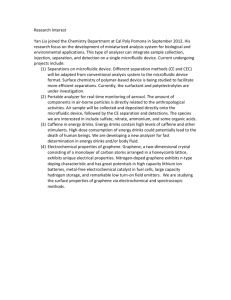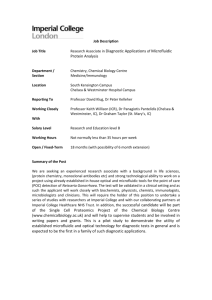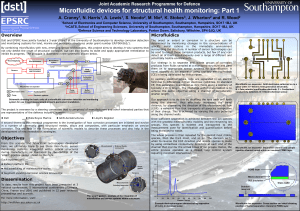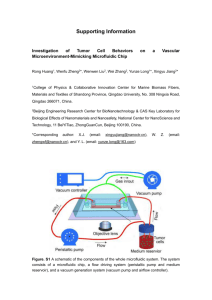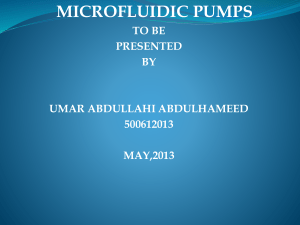Microfluidics and Their Role in Biomedical Applications
advertisement
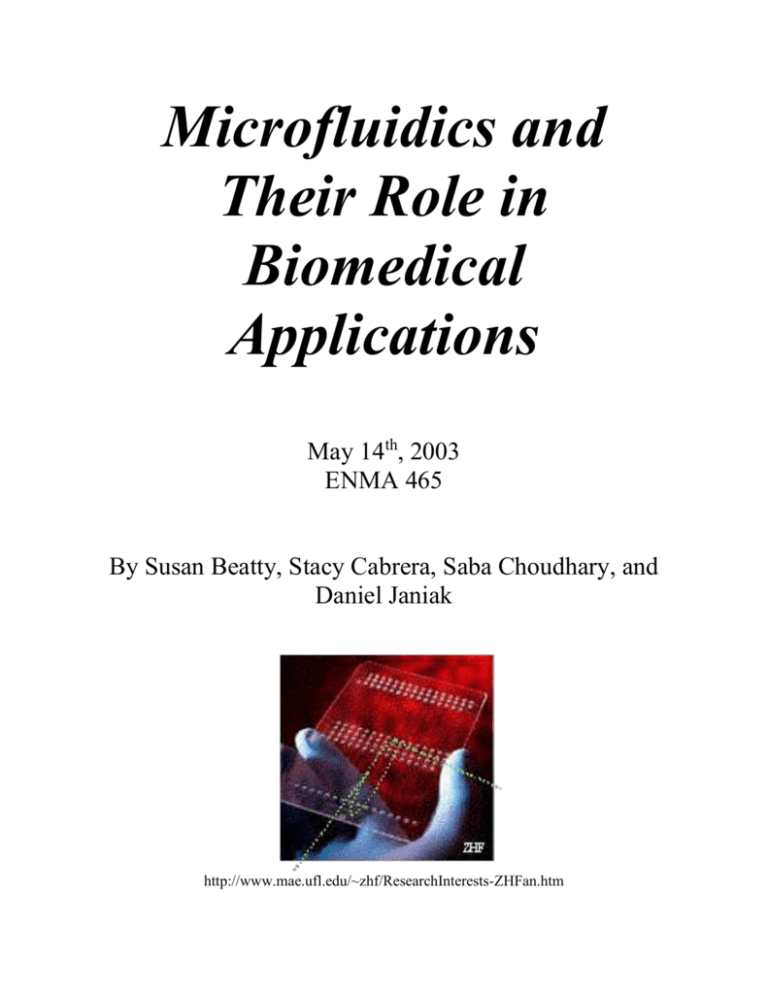
Microfluidics and Their Role in Biomedical Applications May 14th, 2003 ENMA 465 By Susan Beatty, Stacy Cabrera, Saba Choudhary, and Daniel Janiak http://www.mae.ufl.edu/~zhf/ResearchInterests-ZHFan.htm Executive Summary Microfluidics focus on controlling the flow of liquids and gases in systems with dimensions on the microscale. These fluids are dealt with in nano and picoliter amounts and are subject to specific properties at this level. Microfluidic devices are very promising to biomedical applications and play a key role in the future of laboratory testing. Applications in this area can range from detecting toxins in the air to identifying DNA sequences. The idea behind “lab-on-achip” processes is that a macroscale laboratory and all of its functions can be downsized to fit on a microchip. Micro-dosing systems are also being developed for drug delivery with microfluidic systems that involve channels, pumps, valves, and sensors. In the beginning of the research, the material of choice was silicon. Because silicon is not completely bioinert and fairly expensive to process, manufacturers have since moved to plastics. Some of the common materials reviewed include Polyimide, Parylene, PDMS, and Diamond-Like Carbon films. The primary process for making the channels of the device is soft lithography, while micromachining is used to create other features like valves. A key component to a microfluidics system is a valve. The materials and processes of choice depend on the valve being manufactured and the function of the valve within the system. One of the main key concepts currently being improved on is mixing techniques among fluids with only laminar flow properties The future of microfluidics is to continue to take the processing to a smaller and smaller level with increasing speed, accuracy and range of tests being conducted on a microchip. Key Words: Microfluidics, biomedical, valve device., soft lithography 1 Table of Contents Executive Summary 1 Introduction 3 Biomedical Applications Overview 4 Lab-on-a-chip 6 Drug Delivery and Micro-Dosing Systems 6 Microfluidic Device Focus: Valves 7 Materials 8 Processes Overview 11 Fabrication of a Valve 13 Future of Microfluidics 15 References 16 2 The idea is that once you master fluids at the microscale, you can automate key experiments for genomics and pharmaceutical development, perform instant diagnostic tests, even build implantable drug-delivery devices—all on mass produced chips. It’s a vision so compelling that many industry observers predict microfluids will do for biotech what the transistor did for electronics. - Rebecca Zacks for Technology Review Jan/Feb 2001 Introduction In the most general sense, microfluidics is the flow control of tiny amounts of gases or liquids in a miniaturized system on a microchip (Fluidigm, 2003). This is a growing area of biotechnology that will attempt to bring an entire lab, all its equipment, and its range of tests to a single piece built on a microscale. Examples of microfluidics can be found in nature—one prominent one being the human body’s oxygen transport system. Fluid (plasma carrying tiny red blood cells) is moved through tiny capillaries bringing the material to all extremities of the body (Holl et al., 2002). In comparison, microfluidic systems in biotechnology are made up of a combination of channels, pumps, valves, and sensors and are referred to as Micro Total Analysis Systems (mTAS). These channels and chambers within the systems are at the dimensions of tens of hundreds of micrometers (Holl, et al., 2002). The motivation behind developing microfluidics is the properties of laminar flow that exist within the system. On a macroscale, laminar, turbulent and random flow exists for fluids whereas there is only laminar flow on a microscale. Because only this particular type of flow exists in confined spaces, micro channels create special environments that provide controlled mixing—a critical step in expediting chemical reactions (Holl et al., 2002). The area of microfluidics is also looked to for its low thermal mass and efficient mass transport (Holl, et al., 2002). Finally, these miniature systems are the first step to automating complex experimental processes (Fluidigm, 2003). The processing of microfluidic systems is just as important as the inventions of them. Microfabrication methods from the electronics industry have been adapted to microfluidic system processing. Methods range from “printing” to soft lithography and everything in between. Different materials types, such as ceramics and plastics are also used to make the various parts including the pumps, valves, and channels. 3 The future of microfluidics can bring professional, large scale, cumbersome, yet important tests to an individual, at-home level by building personal microfluidic devices, similar to the way microcomputing brought a computer into nearly every person’s home. The focus lies on uses in biotechnology but the possibilities for electronics and more exists. Biomedical Applications Overview Microfluidics studies the behavior of liquids and gasses at the micro level and exploits these properties, or finds methods of circumventing them, in applications and designs for device fabrication. Microfluidic devices combine the advantages of the chemical and physical properties of liquids and gasses at the micro level with the electrical properties of semiconductors on a single chip. This breakthrough in technology finds great potential in the biomedical field. Applications range from detecting airborne toxins to analyzing DNA sequences. Advantages in using these small-scale devices rather than conventional systems include: compact size, disposability, increased functionality, and they require smaller volumes of reagents and samples. According to Harold Craighead of Cornell University, himself a researcher in the area, commercialization of the technology is seen for more rapid DNA sequencing, chemical analytical systems, manipulating cells, and doing general biological procedures (Gwynne, 2000). The optimism surrounding the future of microfluidics is reinforced by the fact that fabrication of the devices involves techniques compatible with those already used in batch processing standard semiconductors. “That should allow future microfluidics devices to be made quickly and cheaply in a microchip factory,” according to Carolyn Matze of the Compound Semiconductor Research Lab at Sandia National Labs (Gwynne, 2000). According to Dr. David Beebe of the University of Wisconsin, simple methods have been developed that enable functionality in microfluidic systems. Using basic physical phenomena of fluids that dominate at the micro-scale (e.g. diffusion, surface tension), one can create new functionality, elegant system designs, and low cost manufacturing methods. “The use of liquid phase photopolymerization allows for the realization of channel networks in a few minutes. Extensions into three dimensions 4 are possible by leveraging surface tension effects. Surface tension effects can also be exploited to achieve sample concentration and pumping schemes as well as the creation of ‘virtual’ and liquid walls providing new functionality in microfluidic systems. Gel matrices can be used to achieve filtering and display functions. Autonomous function is possible by utilizing materials that undergo direct chemical to mechanical conversions enabling elegant system design (e.g. active valves, closed loop feedback control without electronics). Heating and cooling via chemical reactions further eliminates the need for electronics and batteries in order to achieve complex functionality. Further, simple microfluidic systems can enhance in vitro environments and enable improved study of living systems.” (Beebe, 2002). Microfluidics has been used in the Gene Chip technology. Gene chips are also known as DNA chips or DNA microarrays. This technology is used to analyze thousands of genes at a time. Gene Chips are covered with grid-like patterns of short DNA strands, called probes, each of which can specifically bind to a different gene sequence. When sample DNA is placed on the chip, researchers can study which probes bind DNA from the sample to determine which genes were present in the sample. This is applied in analyzing cancerous cells to discover which genes are present in the cancerous cells that are not present in healthy cells. Furthermore, cells can be treated with drugs, and the gene chip can analyze those genes to determine which genes are turned on or off by the drug. Evidently, using a gene chip can be the equivalent of thousands of conventional genetic tests since there are hundreds of thousands of probes on a single gene chip. Hence, gene chips have dramatically accelerated the pace of genetic research (Wikipedia, 2002). The Neural Engineering Laboratory of the Department of Biomedical Engineering at Michigan University is researching the possibilities of Neural microfluidic devices for the intracerebral delivery of neuro-active compounds. Advances in protein and peptide chemistry provide many neuro-active compounds that have therapeutic potential as neuro-protective treatments. The challenge lies in systematically delivering these molecules without the hampering effect of degradation and metabolism. The only option in the past has been to give large doses of medication, which can have detrimental effect on other parts of the body. In addition, the blood-brain barrier poses a significant obstacle for the delivery of these molecules. This challenge can be faced with the advent of microfluidic technology, which is leading into many novel ideas for drug delivery (Kipke, 2002). 5 Lab-on-a-Chip Microfluidic lab-on-a-chip systems hold great potential for many laboratory applications. Labs-on-a-chip can perform the same specialized functions as their macroscopic counterparts, with the additional advantages of using very small sample size, very short reaction and analysis time, and high throughput. These chips can perform clinical diagnoses, scan DNA, run electrophoretic separations, act as microreactors synthesizing novel compounds, and are selfcontained chromatographs (Li, 2002). The gene chip, which was mentioned earlier, is one example of a lab-on-a-chip. The typical lab-on-a-chip is a thin glass or plastic plate, a few centimeters on a side, with a network of microchannels etched into its surface, and strategically placed electrodes on the chip. Microchannels are about 10 microns deep, 50 microns wide, and several centimeters in length. A simple experiment begins by injecting a liquid sample, which can be as little as several picoliters, at one end of a microchannel. Electric fields propel the sample along a predefined route, past reservoir chambers that squirt measured amounts of reactants, and over detectors scrutinizing the progress of the reaction. On such a chip, hundreds of different reactions and analyses can be performed at the same time through hundreds of parallel microchannels (Li, 2002). In order to manipulate fluids and obtain the desired results, labs-on-a-chip must be able to perform the following functions on a microscopic scale: pumping, metering, switching flow, dispensing, mixing, and separating (Li, 2002). This can be done by integrating many devices (such as pumps, valves, etc.) onto a single chip. Drug Delivery and Micro-Dosing Systems Micromechanical dosing systems were the first microfluidic systems to be described. A dosing system consists primarily of a micropump and flowsensor, and can be used in drug delivery systems that are needed in the medical field (Koch et al, 2000). One example of a drug delivery system was mentioned earlier: the research of a drug delivery system for neuro-active compounds, where the challenge lies in delivering these drugs across the blood-brain barrier, and into the central nervous system without them being degraded and metabolized on the way there. Similarly, research has been conducted on drug delivery systems for insulin and painkillers (Koch et al, 2000). 6 The purpose of the insulin micropump system is to mimic the action of the pancreas by continuously giving the body a supply of insulin to maintain blood glucose levels within a normal range, which can work 24 hours a day. In the past, insulin and painkillers have been given in high doses in order to last for several hours. This high dosage approach gives an initial high concentration, which is well above the required level being used. This results in a consequent wastage of insulin or a possible addiction in the case of painkillers, such as morphine (Koch et al, 2000). Macroscopic insulin pumps have already been implanted into the human body. However, these systems contained no closed-loop system to monitor glucose levels and regulate the injection of insulin on demand. This system can be improved by further development of microfluidic devices with glucose sensors. This microfluidic device could improve the quality of life for diabetic patients as it could be implanted in the human body and have the desired monitoring and regulating characteristics (Koch et al, 2000). A similar system could be used for painkillers, to inject the medicine locally and not globally, which reduces the probability of addiction (Koch et al, 2000). In addition, this could result in much faster relief because the painkillers are being delivered to the desired sight, almost instantly. Such a system has been developed and tested at the Maternity Hospital in Dublin, Ireland (Koch et al, 2000). Microfluidic Device Focus: Valves A microfluidic system is the product of device integration. Many devices, such as valves, pumps, flowsensors, fluidic mixers, and biological and chemical sensors are integrated into a single substrate to design microfluidic systems (Koch et al, 2000). The focus of this section is the valves used in microfluidic systems. This device is of two types: active and passive (Koch et al, 2000). Active valves are complicated structures because they include a form of actuation. In principle, a flap controls the flow by actively opening or closing the passage for the fluid. Methods of actuation include thermal actuation, electrostatic actuation, thermopneumatic actuation, and peizoelectric actuation. On the other hand, passive valves do not include any 7 actuation, and are designed to give a high flow rate in one direction and a small flow rate in the opposite direction. Passive valves find their main application in mechanical micropumps, because it is necessary for valves to direct the flow of fluid through these pumps. Passive valves include cantilever valves, diaphragm valves, bivalvular valves, and diffuser nozzle valve (Koch et al, 2000). Cantilever valves generally consist of a thin flap, which controls the flow through the valve system, sitting on top of a duct. When the pressure is lower downstream from the valve than upstream, the cantilever bends into an open state, allowing fluids to pass through. However, when the pressure is higher upstream from the valve, the flap is pressed against the valve seat and is forced to be in the closed state. Diaphragm valves are similar in principle to the cantilever valves, but they incorporate diaphragms for controlling the flow. In essence, the fluid must deflect the diaphragm with sufficient pressure in order to pass through the valve. The bivalvular valves are made with two flaps, which close on each other to form a “V” shape. This type of valve is analogous to double doors, which open from the center (i.e. one swings open to the right, while the other swings open to the left). The diffuser nozzle valve is different because it makes possible two different flow regimes. If the taper angle is small, the diffuser direction is preferred compared to the nozzle direction. However, if the angle is enlarged, the flow changes to the nozzle direction (Koch et al, 2000). Materials When intense research into microfluidics began in the early 1990s, the material of choice for many microfluidic devices was silicon. Silicon was readily available and there was an abundance of well-understood processing techniques because of the growing interest in microelectronics. As biomedical uses for microfluidic devices became more apparent, many of the researchers in the field were drawn to plastics as a low-cost, low complexity alternative to silicon microfluidic devices. In addition, it was determined that silicon was not entirely bioinert, making it highly undesirable for use in biomedical applications. Plastics can be patterned easily through hot embossing and imprinting, both of which are inexpensive compared to common processes used for silicon. The low cost of plastic devices 8 make them disposable; an important feature considering it is best to use microfluidic devices only once to avoid contamination. Currently there are a staggering number of different materials used to build microfluidic devices. The following section gives an overview of some of the more common materials being used. Polyimide is a commonly used polymer for microfluidic devices because it is a high quality substrate into which complex microchannels can be easily machined. In addition, it is easy to sputter metals such as Al, Ti, or Pt onto its surface. This can be extremely useful for creating electrical contacts in microfluidic devices to induce flow with the use of an electrical current (Nguyen, 2002). Parylene is another polymer that is commonly used as a substrate and coating. Parylene has desirable physical and electrical properties in combination with a low permeability to moisture and low susceptibility to corrosion. In addition, a type of Parylene called Parylene D has the ability to withstand high temperatures. Parylene’s properties make it an excellent candidate for biomicrofluidic applications (Nguyen, 2002). PDMS is perhaps the most commonly used polymer in the entire field of microfluidics. Not only is it used as a structural material for microfluidic devices, but it is also used as a stamp for microcontact printing and as a replica master for the micromolding processes. PDMS has as low interfacial free energy, meaning most other polymers and fluids will not have an affinity to stick to or react with its surface. In addition, PDMS is stable against humidity and a wide range of temperatures. Its durability and elastic properties make it highly desirable as a stamp, as these properties allow it to stick to non-planar surfaces (Fujii, 2002). Some of the main drawbacks of using PDMS for biomicrofluidic devices are that due to its permeability it has the tendency to swell when it comes in contact with some organic solvents. This puts limitations on the experiments that researchers can perform using PDMS devices. Another disadvantage of using PDMS is that its elastic properties can cause problems when the aspect ratio of a structure is too high or too low. Specifically, regions of high aspect ratios can attach to each other, an effect known as pairing, while regions of low aspect ratios can sag dramatically (Nguyen, 2002). Diamond-Like Carbon films (DLC) have been successfully used as structural materials for microfluidic devices. DLC films have high hardness and are chemically inert, making them useful for devices where highly toxic or corrosive fluids are being studied (Massi, 2003). 9 Properties of materials used for building devices (valves, pumps, etc.) other than simply microchannels can vary greatly from one device to the next. In most cases, a material is selected based on the specific operation of the device. This leads to an enormous number of different materials being used. For valves specifically, it is an extremely common practice for researchers to choose materials in which a volume changed can be induced. Conductive polymers, paraffin, and polythethylene glycol (PEG) are three materials with in which such a volume change can be induced. Conductive polymers, also known as conjugated polymers, are gaining the attention of many researchers as an inexpensive and effective way to create microfluidic devices such as micropumps and microactuators (Nguyen 2002). Polymers are classified as conjugated when they have alternating single and double carbon bonds throughout the length of the backbone chain. The structure of the chain creates a bandgap within the polymer, and for this reason conjugated polymers are sometimes referred to as “organic semiconductors.” These polymers have the same behavior as inorganic polymers such as silicon; in other words, the conductivity of the polymer depends on its doping level. The doping level of a conjugated polymer in turn depends on its oxidation state. In one specific case, Smela et al. have discovered ways to cause a polymer to undergo volume changes based on its doping level. The first step of creating a polymer capable of undergoing volume change is oxidizing (doping) the polymer. To neutralize the (+) charge on the doped polymer, a large, immobile anion is introduced to the polymer by placing the polymer in contact with an electrolyte solution. Upon reduction (undoping), a cation enters the polymer to neutralize the charge. The volume of the polymer increases as a result of the cation entering. In the case of small immobile anion initially located within the polymer, there is a decrease in the volume of the polymer upon reduction (undoping). Both of these cases are represented visually by the figure below. The polymer Polypyrrole was used by Smela et al. because of the fact that it is highly stable in aqueous environments. In addition, it should also be noted that the large anion used by Smela et al. was dodecylbenzenesulfonate (DBS). In both cases, it is the movement of ions into and out of the polymer that create the volume change. This volume change can be exploited to create valves and actuators suitable for use in microfluidic devices (Smela, 2003). 10 Large Immobile Anion: P+(A-) + C+ + e- P(AC) Small Mobile Anion: P+(A-) + C+ + e- P + A- + C+ Polyethylene glycol (PEG) (Mastrangelo, 2003) and paraffin (Klintberg, 2003) have been used in similar ways to fabricate micropumps and actuators. The volume change associated with each of these materials as result of their respective transformations from solid to liquid phases can be exploited to create valves in microfluidic devices. While the exploitation of volume changes in materials is one of the most common ways to create valves and actuators, many devices are being created using other innovative methods. Low temperature co-fired ceramic tapes, for example, have been used to induce flow patterns and create pumps in microfluidic devices. LTCC tapes are highly dielectric and the layered manufacturing process used to create these films makes it easy to integrate complex conduits and metallic paths within them. By using magneto-hydrodynamics, a process in which magnets are used to induce flow, researchers have been able to create complex flow patterns with LTCC tapes. The complex flow patterns have proven to be useful for mixing and stirring fluids in microfluidic devices (Zhong, 2002). As devices built from certain materials prove to be more useful than others, the variation in materials used for biomicrofluidics will undoubtedly decrease. Until that time, the trend of using specific materials for specific devices will continue unhindered. Process Overview Within a microfluidic device there are channels pumps and valves. For each component there are a set of processes that are used to create that component. It is the combination of all these processes that creates the device. The key element for any microfluidic device is the fluid channels. The channels are created by a process called soft lithography. Soft lithography begins with a silicon wafer. This wafer is patterned using a negative photoresist. 11 Patterning of the silicon substrate (Fisher, 2003) The patterned silicon is then used as a mold for the material to be used. The soft, in soft lithography refers to the soft polymer material that is used. The polymer is then cured and peeled from the mold. Curing and peeling of PDMS (Fisher, 2003) The product is either then used directly for the device, or is used as a stamp or printing surface. The method to create the closed channels essential to microfluidics is embedded in the patterned silicon mold (Fisher, 2003). Another process used for creating microfluidic systems, especially in valves, is micromachining. Micromachining consists of both surface micromachining and bulk micro machining. Both of theses terms describe a family of processes that occur in micro systems. 12 Bulk micromachining affects the profile of the material. Etching is an example of bulk micromachining because materials are removed from the bulk of the material. Both wet and dry etching can be used, however, wet etching is more common. In surface micromachining thin layers are added to the surface of the wafer or other substrate. Deposition is included in this category as well as other techniques like microcontact printing (Whitesides, 2003). In microcontact printing, the previously described cured PDMS is used as a stamp, to deposit thin layers in patterns. While other more specific processes occur for the production of microfluidic devices, these processes outline the general method by which these devices are made. Fabrication of a Valve Each different type of valve is processed differently. All valves are processed through a combination of micromachining techniques. The order and number of steps is dependent on the type of valve. For a detailed explanation of process, the diaphragm check valve will be discussed. (a) (b) (c) Examples of diaphragm check valves ((a)Xie, 2001 (b)Whitesides, 1998 (c)Koch, 2000) This process will focus on valves similar to (a) and (c). Both of these valves begin with the same step. This step is to etch holes into the silicon on the bottom surface of the valve. This process is done using double-sided alignment (Xie, 2001). For valve (a) the silicon is not fully 13 etched through, but rather a thin membrane is left. After etching there is a metallic layer, chromium or gold in this case, evaporated onto the silicon surface. To help with adhesion the entire surface is lightly etched with BrF3 vapor. Etched silicon with deposited gold (Xie, 2001) Next, a photo resist layer is patterned and deposited, and the polymer layer is deposited on top of that. Deposited photoresist (pink) and polymer (green) (Xie, 2001) The final step involves etching the silicon membrane at the bottom surface and dissolving the photoresist in acetone. For this particular valve the seal between the metal and the polymer must also be broken to ensure proper functioning. Valve (c) is processed in a similar fashion with a few differences, the primary difference being the lack of the metal seal. After the etching of the silicon a phosphosilicate glass is deposited by chemical vapor deposition. Photoresist is patterned and applied on top of the glass and dry etched. Etched glass with photoresist on silicon substrate (Koch, 2000) Poly silicon is then deposited and a positive photoresist applied on top. The silicon is then etched. 14 Deposited poly silicon and resist after etching (Koch, 2000) The last step is etching the sacrificial layers. To protect the polysilicon a nitride is deposited using chemical vapor deposition. The system is then etched using KOH. Care should be taken to ensure the etching stops at the glass (Koch, 2000). Final valve (Koch, 2000) The specific processes between different types of diaphragm valves change. The overall process is the same, but the number of steps involved can vary. Future of Microfluidics The goal of microfluidics is to take the equipment needed for everyday chemistry and biology procedures and shrink it to a system the size of a postage stamp. The advantages of this branch of biotechnology include increased speed, accuracy and ability of testing and decreased costs. One example of the type of improvements that are waiting science in the field of microfluidics is with the sorting of DNA-type samples. To sort something like proteins or DNA into different sizes (when done by electrophoresis) takes about 30 minutes on a bench but less than 30 seconds on a chip. Also, volume measurements in microfluidic systems are more accurate, which cuts down on the error involved. Along with the continuous downscaling of these devices comes an integrated problem of mixing fluids on the nanoscale. With only laminar flow at this level, liquids want to flow next to 15 each other without mixing. Although this phenomenon is often times desired, processes and designs are being developed for the times that it is not. One design involves adding ridges to the sides of the channels to force the liquid to swirl as the center folds in on itself and mixes (Knight, 2002). Another method is done with a shaking of the liquid in the device to induce mixing sooner than would occur naturally in the system (Knight, 2002). Small ridges along the channel walls can force mixing by a kneading motion (Knight, 2002). The future of microfluidics serves not only to bring the size of the lab to be able to exist on a microchip, but also to bring to skill of the laboratory technician to exist within the properties and abilities of the device. This branch of research is still in its beginning stage and shows huge promise with its integration into both science in the lab and science at home. Researchers will continue to strive to increase the range of tests that can be performed at the micro level and the accuracy and speed with which these tests are performed. References Beebe, David. “Microfluidic Phenomenon and Polymer-Based Microfluidic Devices.” Third Annual BioMEMS & Biomedical NanoTech Conference. September 2002. Accessed March 2003. <http://www.healthtech.com/2002/bms/abstracts/plenery1.htm> Chronis, Nikolas, “Micro Scale Fluid Mechanics: A Review.” Power Point Presentation, November 21, 2000. Accessed April 15, 2003. <http://plasmalab.berkeley.edu/xyz/ references/Micro%20Scale%20Fluid%20Mechanics.pdf> Fan, Z. Hugh. “Research Interests.” Accessed April 21, 2003. <http://www.mae.ufl.edu/~zhf/ResearchInterests-ZHFan.htm> Fisher, T.S., K.E. Torrance.”Nanoscale Thermofluid Laboratory” Accessed April 7, 2003 http://www.ee.washington.edu/research/microtech/cam/CAMsoftlithhome.htm/ 16 Fluidigm Corporation. 7100 Shoreline Court South San Fransisco, CA 94080. Accessed April 15, 2003. < http://www.mycometrix.com/about.htm> Fujii, T. “PDMS-based microfluidic devices for biomedical applications.”Microelectronic Engineering, Volumes 61-62, Pages 907-914 (July 2002) http://www.sciencedirect.com/science?_ob=GatewayURL&_method=citationSearch&_u oikey=B6V0W-458P5M8-2&_origin=EMFR&_version=1&md5=ea5c201987 c50419a9bb06f6c3b9a4f3 Grigorov, K et al. Plasma etching of DLC films for microfluidic channels, Microelectronics Journal, In Press, Corrected Proof (Available online 2 April 2003) <http://www.science direct.com/science?_ob=GatewayURL&_method=citationSearch&_uoikey=B6V 44488 NX0V-3&_origin=EMFR&_version=1&md5=bdb6bd5a7d899aa4631c67b7b55a0956> Gwynne, Peter. “Microfluidics on the move: devices offer many advantages.” OE Reports, Technology and Trends for the International Optical Engineering Community.The International Society for Optical Engineering, August 2000. Accessed May 8, 2003. <http://www.spie.org/web/oer/august/aug00/home.html> Holl, Mark, et al. “Microfluidics.” Science Magazine, Vol. 297, No. 5584, August 16, 2002, pp. 1197-1198. Kipke, Daryl. “Neural Microfluidic Devices.” July 2002. Accessed March 2003. <http://www.eecs.umich.edu/NELab/ANIC.htm> Klintberg, L, et al. “Fabrication of a paraffin actuator using hot embossing of polycarbonate.” Sensors and Actuators A: Physical, Volume 103, Issue 3, Pages 307-316 (15 February 2003) http://www.sciencedirect.com/science?_ob=GatewayURL&_method=citation Search&_uoikey=B6T HG-47T8DVY_origin=EMFR&_version=1&md5=de 251626474576ec085fd2d6b528386b Knight, Jonathan. “Honey, I Shrunk the lab.” Nature, Vol. 418, August 2002. Accessed May 8, 2003. <http://depts.washington.edu/bioe/shrunklab.pdf> Koch, Michael; Alan Evans, Arthur Brunnschweiler. Microfluidic Technology and Applications. Baldock, Hertfordshire, England: Research Studies Press LTD. 2000. Lee, Y-S, et al. “Plasma-deposited amorphous silicon carbide films for micromachined fluidic channels.” Applied Surface Science, Volumes 144-145, Pages 708-712 (April 1999) http://www.sciencedirect.com/science?_ob=GatewayURL&_method=citationSearch&_u oikey=B6THY-3Y901KS9B&_origin=EMFR&_version=1&md5=da36c14a 12935d946621228da10954a0 Li, Dongqing. “Labs on a Chip and Quantitative Microfluidic Technology.” 2002. Accessed April 14, 2003. <http://www.mie.utoronto.ca/staff/profiles/dli/dli.html> 17 Mastrangelo, C.H. et al. “Polyethylene glycol (PEG)-based actuator for nozzle-diffuser pumps in plastic microfluidic systems.” Sensors and Actuators A: Physical, In Press, Corrected Proof (Available online 22 March 2003) <http://www.sciencedirect.com/science?_ob =GatewayURL&_method=citationSearch&_uoikey=B6THG-486G7X8-2&_origin =EMFR&_version=1&md5=f9754a8e 4cd6df07d8e1a7978c25a066> Nguyen, N. Fundamentals and Applications of Microfluidics. Boston: Artech House, 2002. Smela, E. http://www.wam.umd.edu/~smela. March 14, 2003. Wikipedia Encyclopedia. “Gene Chip.” September 2002. Accessed March 2003. http://www.wikipedia.org/wiki/Gene_chip Whiteside, GM. “Microfluidics” accessed April 10, 2003 http://gmwgroup.harvardf.edu/domino/html/webpage/homepage2.nsf/res:%20microfluidi cs?OpenPage Whiteside, GM, et al. “Soft Lithography” Annual Review of Materials Science(USA) vol 28 pp153-184 1998 accessed April 7, 2003 http://matsciannualreviews.org/cgi/content/full/28/1/153 Xie, J., et al. “Suface Micromachined Leakage Proof Parylene Check Valve”accessed May 9, 2003 <touch.caltech.edu/publications/2001/ mems2001/checkvalve/checkvalve.PDF> Zacks, Rebecca. “Microfluidics.” Technology Review, January/February 2001, pp 14-15. Accessed April 15, 2003. < http://www.technologyreview.com/purchase/pdf_ dl.asp?79juh=541729&hy6f0=1316> Zhong, J., et al. “Magneto hydrodynamic (MHD) pump fabricated with ceramic tapes.” Sensors and Actuators A: Physical, Volume 96, Issue 1, Pages 59-66 (31 January 2002) http://www.sciencedirect.com/science?_ob=GatewayURL&_method=citationSearch&_u oikey=B6THG-44J6KJG-1&_origin=EMFR&_version=1&md5= 580b6e3ff3eaccbad210a8dee54a4f67 18
